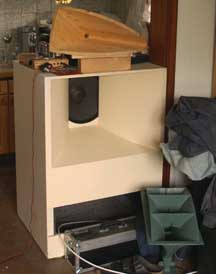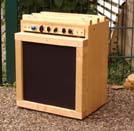
The Mother of Tone
After reading the Vibration & Character chapter, you may wonder what actually IS a good character for a vibration?
This is - since the advent of the bush-drum - the basic question for the makers, players, and listeners of musical instruments.
In the old days, music was all about the sound of bones, wood and animal-skin.
Later on, we added paper, brass, felt, steel, and silver.
Today we have much more materials involved: aluminium, thousands of kinds of plastics, copper, ceramics, titanium, mdf-plates, rubber, just to name few.
Every material has its own tonal character. According to Dieter, the character is further determined by the material's temperature.
Knock on any material and Listen to the Sound.
Every material will sound different and one cannot say that any material sounds bad since each sound may be interesting and new for us. However, if you listen to a material for a longer time, it may happen that your nerves are somewhat blank.
We cannot listen to brass all day, neither to titanium or plastic or aluminium.
But which material has the most pleasing tone ?
The answer is simple: Which material do YOU consist of ?
Bones and flesh. That's it.
The ear, your listening organ, has its own tonal character, according to its construction and the cellular material it consists of.
Like any microphone has a tonal character, your ears have too.
This is the 'Mother of Tone' character.
Would your ears be made of aluminium, they would have a different tonal character. But this is not the point. The point is, that the tonal characteristic of your ear is the yardstick for any sound you are able to perceive, and that sounds are evaluated in a way that corresponds to the distance or strangeness with respect to the Mother-of-Tone character.
According to the Law of Attraction (like attracts like), the sound-character of a material that comes close to your own material is pleasing, whereas a sound character starts to hurt, the less the sound emanating material has to do with your own cellular material.
This is a simple realization, but you can explain a whole musical world with it. The characteristic construction and material of your ear is the yardstick, and the more a sound comes close to that characteristic, the better you feel and the more you are attracted to that sound.
Try for your own. Listen attentively to sounds you like and dislike and see what materials are involved.
Okay, how to make use of that ?
Since we cannot make hifi-equipment out of flesh and bones, we have to look for a material that is at hand, and is related to our ears characteristic.
This material is wood. A cellular plant material. Ideal for the construction of musical instruments, loudspeakers, etc.
In fact, our whole body is put together by digesting plant material. Even if we eat a Steak, the cow has been eating plants before. So we are much more related to wood, than we are to ceramics, aluminium, plastics, steel or titanium.
This is the reason that ...
... Wood Sounds Good
In fact, almost every kind of wood sounds good.
Some are bright (i.e. maple), some are soft (swamp ash) and some are in between (mahogany). But they all sound good to us (massive boards are prefered over particle or mdf boards).
My personal favourite is spruce, a lightweight, fast growing wood that is cheap and available from sustainably managed forests. Btw. Dieter put my attention on this wonderful wood.
Spruce has a long history in classical musical instruments: The violin, viola, cello, double bass as well as today's more expensive electric jazz guitars all have solid spruce tops.
Pianos and grand pianos have spruce soundboards.
Did you ever wonder why a violin or piano does not sound right on your hifi-system ? It just can't be any other way with a polypropylene, aluminium, beryllium, ceramic or titanium speaker cone and your plastic-lacquered mdf-board speaker enclosures.
Okay, let's get practical and take a look at my personal Spruce Gallery:
My most important spruce-experience (besides my tonearm) was the construction of a spruce-horn for my ALTEC LANSING Voice of the Theatre speaker (click pic for larger view).
You see the original ALTEC cast metal horn at the bottom right side of the picture. The musical presentation with the original ALTEC horn is excellent when listening to saxophone, brass and cymbals, but it is not so good with voices, and it just fails with violins and pianos. I tried 802 and 808 drivers but it makes no difference to the character of the sound. So I decided to try out a spruce horn. As you see on the picture I did not care about geometry or any contemporary knowledge concerning the design of horn speakers. Nevertheless, the result is nothing short of amazing. Although the original ALTEC 808 that is used to drive this horn is completely made of metal and has an aluminium diaphragm, the formerly metallic character of voices, pianos and strings is completely gone. The brass and saxes are still great.
The original metallic character was completely transformed by the vibration of the spruce horn.
What I learned from this experiment was, that
a) spruce really sounds great
b) it is possible to transform a bad sounding vibration into a -mother of tone- vibration by using the proper material. As soundwaves are reflected from any material, they adapt the sonic character of that material.
If anyone out there is into horn-speakers and currently listens to a plastic or cast metal horn, try out a spruce horn.
After being encouraged by the spruce horn experience, I built a couple of monitor speakers, a guitar combo amplifier and a bass-guitar box with an ALTEC 416B driver.
However, the material covers one half of the story. The other half is the lacquer.
Altmann Micro Machines … Dipl.-Ing. Charles Altmann… Erlenstrasse 15… 42697 Solingen… Germany
phone +49-212-233-7039… email
- Other Altmann Sites: www.jitter.de www.altmann.haan.de www.amm.haan.de
- AMM reserves the right to make changes without further notice to any products herein to improve reliability, function or design.




